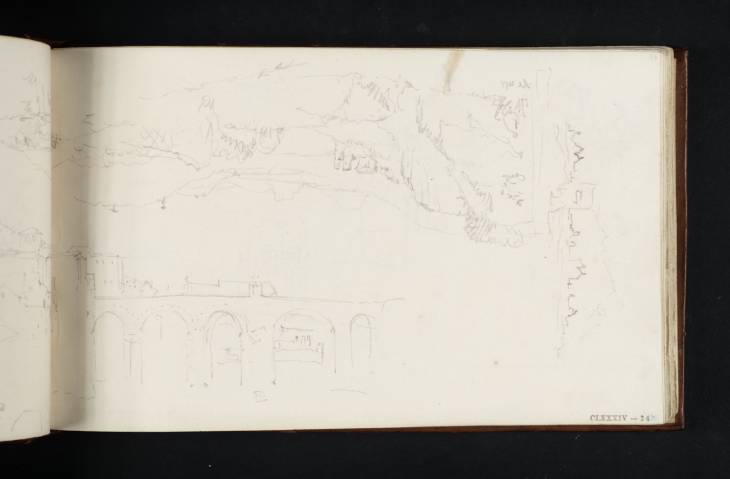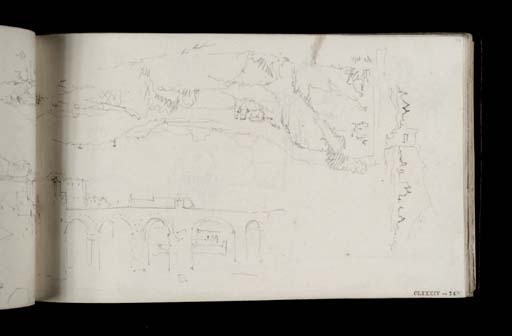Joseph Mallord William Turner The Ponte Romano, Capua; and a View of Lake Avernus, Looking towards Cape Misenum 1819
Image 1 of 2
Joseph Mallord William Turner,
The Ponte Romano, Capua; and a View of Lake Avernus, Looking towards Cape Misenum
1819
Joseph Mallord William Turner 1775–1851
Folio 35 Recto:
The Ponte Romano, Capua; and a View of Lake Avernus, Looking towards Cape Misenum 1819
D15623
Turner Bequest CLXXXIV 34
Turner Bequest CLXXXIV 34
Pencil on white wove paper, 122 x 197 mm
Inscribed by the artist in pencil ‘wall’ bottom left and ‘olive’ centre, within inverted sketch
Inscribed by ?John Ruskin in blue ink ‘281’ bottom right and ‘34’ top right
Stamped in black ‘CLXXXIV 34’ bottom right
Inscribed by ?John Ruskin in blue ink ‘281’ bottom right and ‘34’ top right
Stamped in black ‘CLXXXIV 34’ bottom right
Accepted by the nation as part of the Turner Bequest 1856
References
1909
A.J. Finberg, A Complete Inventory of the Drawings of the Turner Bequest, London 1909, vol.I, p.543, as ‘Do. [Capua]’.
1984
Cecilia Powell, ‘Turner on Classic Ground: His Visits to Central and Southern Italy and Related Paintings and Drawings’, unpublished Ph.D thesis, Courtauld Institute of Art, University of London 1984, pp.179 note 41, 180 note 44, 424, 492 note 44, as ‘Also includes a view of Lake Avernus, looking towards Cape Misenum’.
1987
Cecilia Powell, Turner in the South: Rome, Naples, Florence, New Haven and London 1987, pp.79 notes 34 and 37.
The nineteenth-century route from Rome to Naples passed directly through the town of Capua, and Turner made several sketches of the topography and architecture. The feature in the bottom left-hand corner of this page is the Ponte Romano, seen from the eastern bank of the River Volturno. The composition continues on the opposite sheet of the double-page spread, see folio 34 verso (D15622; Turner Bequest CLXXXIV 33a). A separate drawing parallel with the right-hand side of the sheet also appears to depict a distant view of Capua with the peak of Monte Tifata visible beyond. Further studies of the town can be found on folios 33–34 and 35 verso (D15619–D15621 and D15624; Turner Bequest CLXXXIV 32–33 and 34a).
As Cecilia Powell first identified, the inverted sketch at the top of the sheet represents Lake Avernus, a volcanic crater lake near Pozzuoli, which is represented in classical mythology as the entrance to the underworld.1 This view looking south across the lake towards the Bay of Baiae and the promontory of Cape Misenum (present-day Capo Miseno) was one well known to Turner. He had already painted two oil compositions of the vista prior to seeing it for himself: Aeneas and the Sibyl, Lake Avernus circa 1798 (Tate N00463); and Lake Avernus: Aeneas and the Cumaean Sibyl circa 1814–15 (Yale Center for British Art),2 both of which are based upon a drawing by Sir Richard Colt Hoare (1758–1838), who also commissioned and owned the latter picture.3 A related pencil study can be found in the Turner Bequest (Tate D02381; Turner Bequest LI N). Lake Avernus is also the setting for a later oil painting, The Golden Bough exhibited 1834 (Tate N00371).4
Despite his familiarity with the prospect, Turner made several on-the-spot sketches of Lake Avernus which are scattered throughout the Gandolfo to Naples sketchbook, see folios 19 verso, 27 verso, 71–72, 77–78 (D15592, D15608, D15695–D15697, D15707–D15709; Turner Bequest CLXXXIV 19a 26a, 69–70, 75–79). This particular study disrupts an unrelated sequence of views of Capua. A small part of the drawing spills over onto the opposite sheet of the double-page spread, see folio 34 verso (D15622; Turner Bequest CLXXXIV 33a).
Nicola Moorby
April 2010
How to cite
Nicola Moorby, ‘The Ponte Romano, Capua; and a View of Lake Avernus, Looking towards Cape Misenum 1819 by Joseph Mallord William Turner’, catalogue entry, April 2010, in David Blayney Brown (ed.), J.M.W. Turner: Sketchbooks, Drawings and Watercolours, Tate Research Publication, December 2012, https://www


